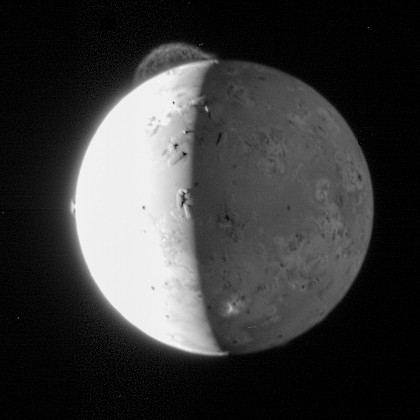Planetary geology is going through a really fertile period at the moment, with numerous probes and rovers sending back mouthwatering images and data from many different parts of the solar system. However, as well as being extremely interesting in its own right, the information being sent back also highlights an important general point for all us geologists: the dominant processes which shape the Earth are not necessarily the same, or as important, or even present, on other planetary bodies.
An example: what do you need for a planet or moon to be volcanically active? Just from looking at how volcanoes work on Earth, you’d say that it needs to be above a certain size, so that it retains enough internal heat (left over from its formation, and from radioactive decay) to sustain mantle convection.
Earth with a diameter of 12,800 km, is large enough to still be volcanically active: Mars (diameter 6800 km) and our Moon (diameter 3400 km) are too small. They were once, but have now lost too much heat and are volcanically dead. However, as this fabulous picture from the New Horizons probe shows, Io (diameter 3600 km) breaks the rules, and not in a small way either: Io is the most volcanically active body in the solar system.

The cause of this departure from our expectations? Extra internal heating caused by the combined tidal influences of Jupiter and the other large Jovian moons like Europa, which are continuously squashing and squeezing Io out of shape. Unlike on this planet, on Io tides really do control volcanoes.
Here’s another: one of the most talked about discoveries made by the Mars rover Opportunity was abundant evidence for the presence of liquid water on Meridiani Planum, including the presence of lots of sulphates. On Earth, these minerals are formed by the evaporation of an isolated, standing body of water, and this was what was initially thought to be the case on Mars too – except that Meridiani Planum is a gently sloping region which does not in any way resemble a restricted basin.
However, a recent paper in Nature (see also here or here) offers a possible answer to this conundrum. It seems that if you model the flow of water below the surface of Mars at the time these deposits were forming, Meridiani Planum is a region of major upwelling; so the evaporates probably formed as a result of the drying out of sediments saturated by mineral rich water upwelling from below, rather than the evaporation of rainwater falling from above. On Earth, except in a few isolated places, it is rare to see the subsurface water cycle dominating over the more familiar surface/atmosphere one, but on quick-drying Mars, it might turn out to be behind many of the features we see.
The idea I’m trying to communicate here is, to a certain extent, an inversion of the normal Copernican Principle, but it is not advocating any hubris on our part. It’s saying that what we observe here on Earth, and even in our solar system given the characteristics of the exoplanets we’ve found so far, is only a small subset of what can be. Something to bear in mind when thinking about things like the possibility of extra-terrestrial life: you can’t tell what’s likely, or normal, from a sample size of one.



Comments (2)